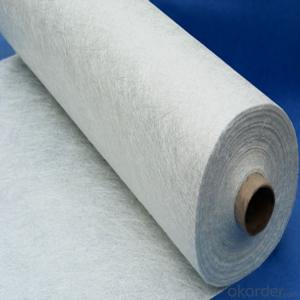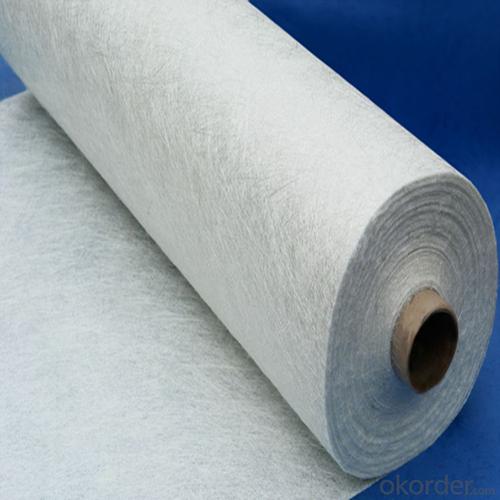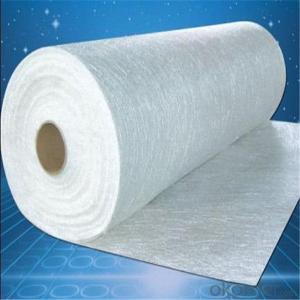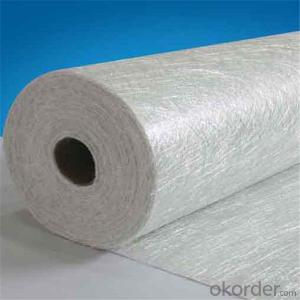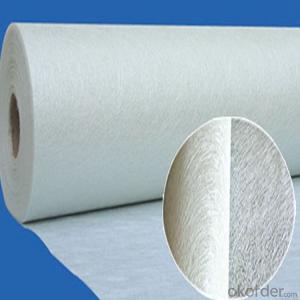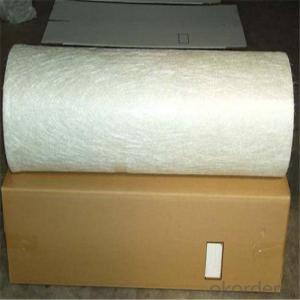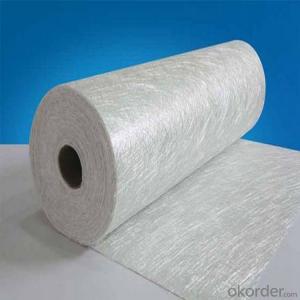Fiberglass Chop Strand Mat E-Glass Fiberglass Chopped Strand Mat
- Loading Port:
- China main port
- Payment Terms:
- TT OR LC
- Min Order Qty:
- 1 kg
- Supply Capability:
- 5000 kg/month
OKorder Service Pledge
OKorder Financial Service
You Might Also Like
Specification
Product Description:

Surfacing Tissue mainly used in the surface layers of FRP products. It features even Fiber distribution, soft feel, level and smooth fiber surface, less glue content, quick resin soak and good pattern fitness. It can improve the product surface property on corrosion resistance, compressive strength, seepage resistance, and longer service life. It is also suitable for spraying; pattern pressing and other FRP pattern technology.
Surfacing Tissue mainly used in the surface layers of FRP products. It features even Fiber distribution, soft feel, level and smooth fiber surface, less glue content, quick resin soak and good pattern fitness. It can improve the product surface property on corrosion resistance, compressive strength, seepage resistance, and longer service life. It is also suitable for spraying; pattern pressing and other FRP pattern technology.
Product Features:
Fast breakdown in styrene
Fiber dispersed evenly
Low binder content
Superior acid corrosion resistance
Specifications:
Item | Over Density | Moisture Content | Chop Density | Polyester Yarn | Width |
(g/m2) | (%) | (g/m2) | (g/m2) | (mm) | |
EMK300 | 309.5 | ≤0.15 | 300 | 9.5 | 50-3300 |
EMK380 | 399 | 380 | 19 | ||
EMK450 | 459.5 | 450 | 9.5 | ||
EMK450 | 469 | 450 | 19 | ||
EMC0020 | 620.9 | 601.9 | 19 | ||
EMC0030 | 909.5 | 900 | 9.5 |
Product Packaging:
Each Surface Tissue is wound onto a paper tube which has an inside diameter of 76mm and the mat roll has a diameter of 330mm. The mat roll is wrapped up with plastic film,and then packed in a cardboard box or wrapped up with kraft paper. The rolls can be vertically or horizontally placed. For transportation, the rolls can be loaded into a cantainer directly or on pallets.
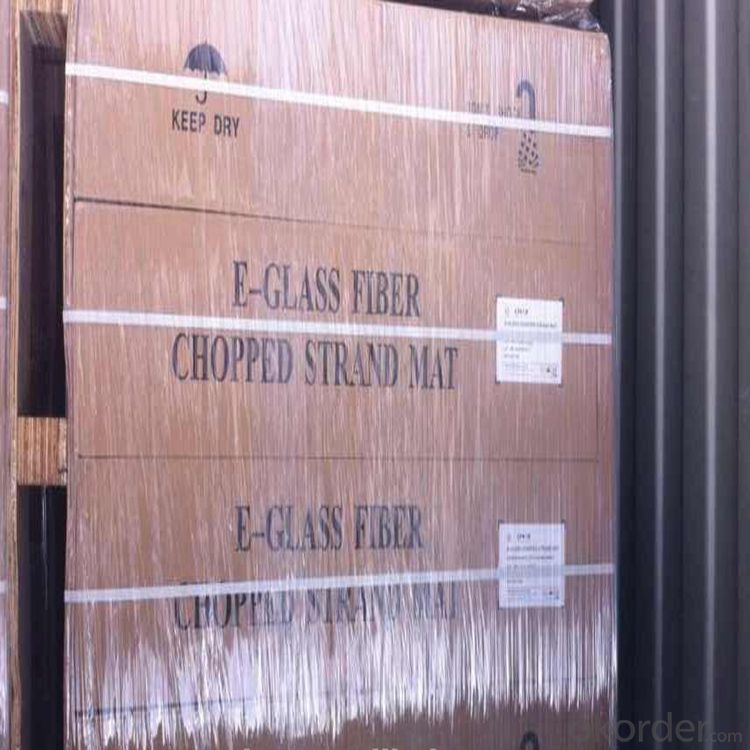
Product Storage:
Unless otherwise specified, Chopped Strand Mat should be stored in a dry, cool and rain-proof area. It is recommended that the room temperature and humidity should be always maintained at 15℃~35℃ and 50%~75% respectively.
Company Information
CNBM (China National Building Material) Group is the largest comprehensive building materials group in China that in integrate scientific research, manufacturing and logistics into one entity. The largest building materials and equipment specialists in China. Upon State Council approval, today CNBM owned more than 300 subordinate manufacturing factories and servicing companies. There are 6 fully owned public listed companies and 11 partially owned with substantial shares public listed companies. In many of these fields, CNBM is playing the leading role in the building industry in the country.

- Q: Is fiberglass chopped strand compatible with thermoplastic resins?
- Yes, fiberglass chopped strand is compatible with thermoplastic resins. Fiberglass chopped strand is commonly used as a reinforcement material in thermoplastic composites. The chopped strands are typically mixed with thermoplastic resins, such as polypropylene (PP) or polyethylene (PE), and then processed using techniques like injection molding or extrusion. The thermoplastic resin melts during processing, allowing the chopped strands to be uniformly distributed throughout the material. This combination of fiberglass chopped strand and thermoplastic resin results in a strong and durable composite material that is widely used in various industries.
- Q: Can fiberglass chopped strand be used in pipe manufacturing?
- Yes, fiberglass chopped strand can be used in pipe manufacturing. It is commonly used as a reinforcement material to enhance the strength, durability, and corrosion resistance of pipes. The chopped strand is typically mixed with resin and formed into a composite material, which is then used to manufacture pipes for various applications.
- Q: Is fiberglass chopped strand compatible with different manufacturing processes?
- Fiberglass chopped strand is indeed compatible with various manufacturing processes. It is a highly adaptable material that finds utility in diverse manufacturing techniques, including compression molding, injection molding, and filament winding. It can be combined with different resins, such as polyester, epoxy, and vinyl ester, resulting in composite materials with a wide range of properties. The incorporation of chopped strand into these processes is a seamless process, ensuring both effective dispersion and reinforcement throughout the final product. Moreover, the usage of fiberglass chopped strand in sheet molding compounds (SMCs) and bulk molding compounds (BMCs) allows for the production of parts that are both lightweight and possess exceptional strength. Consequently, fiberglass chopped strand boasts remarkable flexibility and compatibility with various manufacturing processes, rendering it a highly sought-after choice within industries such as automotive, aerospace, construction, and marine.
- Q: Can fiberglass chopped strand be used in consumer product applications?
- Yes, fiberglass chopped strand can be used in consumer product applications. Fiberglass chopped strand is a versatile material that is commonly used in various consumer products, including but not limited to, automotive parts, sports equipment, household appliances, and furniture. It offers excellent strength-to-weight ratio, impact resistance, and dimensional stability, making it suitable for a wide range of applications. Additionally, fiberglass chopped strand can be easily molded or incorporated into different manufacturing processes, such as injection molding or compression molding, allowing for the production of complex shapes and designs. Overall, fiberglass chopped strand is a reliable and cost-effective material choice for consumer product applications.
- Q: Is fiberglass chopped strand compatible with phenolic resin?
- Yes, fiberglass chopped strand is compatible with phenolic resin. Phenolic resin is commonly used as a binder in fiberglass products, including chopped strand mats. The resin is able to wet out and bind to the fiberglass strands, creating a strong and durable composite material. The compatibility between fiberglass chopped strand and phenolic resin allows for the production of various fiberglass-reinforced products, such as panels, pipes, and automotive components.
- Q: Can fiberglass chopped strand be used in composite manufacturing processes?
- Yes, fiberglass chopped strand can be used in composite manufacturing processes. It is commonly used as a reinforcement material in composites, providing strength and stiffness to the final product. Chopped strand mat, made from fiberglass strands, is often used in hand lay-up and spray-up processes to create various composite products such as boat hulls, automotive parts, and pipes.
- Q: Is fiberglass chopped strand suitable for wind turbine blades?
- Yes, fiberglass chopped strand is suitable for wind turbine blades. Fiberglass is a popular material choice for wind turbine blades due to its lightweight, high strength, and durability properties. Chopped strand fiberglass, which consists of small fibers randomly oriented and held together with a binder, can be easily molded and manufactured into complex shapes, making it ideal for wind turbine blade production. The fibers provide excellent stiffness and strength, enabling the blades to efficiently capture wind energy and withstand the stresses and forces experienced during operation. Additionally, fiberglass is corrosion-resistant, reducing maintenance and prolonging the lifespan of the blades. Overall, fiberglass chopped strand is a suitable and widely used material in the construction of wind turbine blades.
- Q: Is fiberglass chopped strand suitable for the production of marine components?
- Marine components can be effectively produced using fiberglass chopped strand. Fiberglass is widely recognized for its remarkable strength-to-weight ratio, resistance to corrosion, and long-lasting nature, making it an ideal choice for marine applications. Chopped strand refers to the short fibers of fiberglass that are combined with resin to create a composite material. This particular type of fiberglass is commonly utilized in the construction of boats, yachts, and other marine components. Fiberglass chopped strand brings forth several benefits when used in marine applications. Firstly, it offers high tensile strength and stiffness, allowing for the creation of lightweight yet resilient components. This is crucial for marine vessels and structures since they must withstand the harsh conditions of saltwater, waves, and impacts. Furthermore, fiberglass chopped strand exhibits exceptional resistance to corrosion and deterioration caused by water and sunlight exposure. Consequently, marine components made from fiberglass have a lengthier lifespan and necessitate less maintenance in comparison to other materials. Moreover, fiberglass chopped strand can be easily shaped into various forms and sizes, enabling the production of customized marine components. It can be employed for the fabrication of hulls, decks, bulkheads, and other structural parts. The versatility of fiberglass chopped strand also permits the integration of other materials or reinforcements to meet specific requirements. In summary, fiberglass chopped strand is a suitable material for manufacturing marine components due to its strength, corrosion resistance, durability, and versatility. Its numerous advantages have made it a favored choice in the marine industry.
- Q: Is fiberglass chopped strand compatible with vinyl ester resin?
- Indeed, vinyl ester resin and fiberglass chopped strand are indeed compatible. Vinyl ester resin is widely utilized in fiberglass composite applications owing to its exceptional chemical resistance, mechanical properties, and high heat resistance. As for fiberglass chopped strand, it comprises short glass fibers and is commonly employed as a reinforcement material in composite fabrication. When combined with vinyl ester resin, the chopped strand serves to fortify the strength and rigidity of the composite material. Through the resin's binding of the chopped strand fibers, a robust and long-lasting composite is formed, one that can withstand various chemicals and environmental conditions. Thus, it is clear that fiberglass chopped strand and vinyl ester resin are compatible and may be effectively employed together in the manufacturing of composites.
- Q: How does the density of chopped strand composites compare to other materials?
- Chopped strand composites typically exhibit a lower density than many other materials. These composites are created by reinforcing a matrix material, such as resin, with short strands of fibers, usually glass or carbon. These fibers are arranged randomly and contribute to the strength and stiffness of the composite structure. In comparison to metals, like steel or aluminum, chopped strand composites possess a lower density. This is due to the atomic structure of metals, which results in a higher density. Consequently, metals can yield heavier components, which may not be desirable in specific applications where reducing weight is crucial. Conversely, chopped strand composites have a density comparable to or slightly higher than certain polymers. Polymers are lightweight materials that, when reinforced with fibers, can attain greater strength and stiffness than their non-reinforced counterparts. However, the addition of fibers does increase the density of the composite. In general, the density of chopped strand composites falls within a middle range when compared to other materials. It strikes a balance between lightweight characteristics and mechanical properties, thereby making it a suitable choice for various applications where reducing weight, as well as achieving strength and stiffness, are important considerations.
Send your message to us
Fiberglass Chop Strand Mat E-Glass Fiberglass Chopped Strand Mat
- Loading Port:
- China main port
- Payment Terms:
- TT OR LC
- Min Order Qty:
- 1 kg
- Supply Capability:
- 5000 kg/month
OKorder Service Pledge
OKorder Financial Service
Similar products
Hot products
Hot Searches
Related keywords
